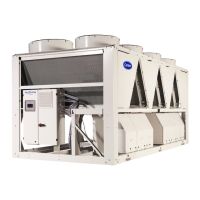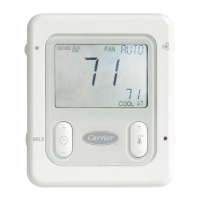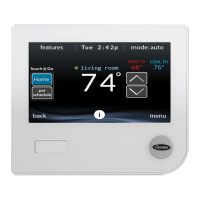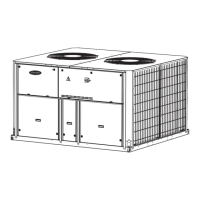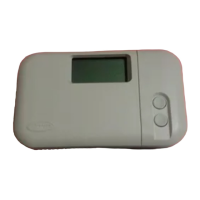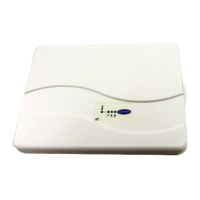35
6 - STANDARD CONTROL OPERATIONS AND OPTIONS
6.5 - Control point
The control point represents the water temperature that the unit
must produce. The required capacity can be decreased depending
on the unit load operating conditions.
Control point = Active setpoint + Reset
The control point is calculated based on the active setpoint and
the reset calculation. The forced value can be used instead of any
other setpoint calculation only when the unit is in the Network
operating type.
To verify the control point
1. Navigate to the Main menu.
2. Select General Parameters (GENUNIT).
3. Verify Control Point [CTRL_PNT].
Control Point [CTRL_PNT]
26.7 to 65.0°C
80.0 to 149.0°F
6.5.1 - Active setpoint
Two setpoints can be selected, where the rst setpoint is used
during occupied periods, whereas the second one is used during
unoccupied periods.
Depending on the current operation type, the active setpoint can
be selected manually via the Main menu on the user interface,
with the volt-free user contacts, with network commands (CCN,
BACnet, Modbus) or automatically with the setpoint time schedule
(schedule 2).
The following tables summarise possible selections depending on
the control operating type (Local, Remote or Network) and the
following parameters:
■ Setpoint selection [sp_sel]: Setpoint select permits selection
of the active setpoint if the unit is in the Local operating type
(GENUNIT – General Parameters).
■ Setpoint switch status [SETP_SW]: Remote Setpoint Switch
(INPUTS – Inputs).
■ Occupied state of dual setpoint time schedule [SP_OCC]:
Schedule for setpoint selection.
Local operating type
Setpoint Select
[SP_SEL]
Setpoint occupancy
[SP_OCC]
Active setpoint
1 sp 1 - heating setpoint 1
2 sp 2 - heating setpoint 2
0 auto occupied heating setpoint 1
0 auto unoccupied heating setpoint 2
Remote operating type
Remote Setpoint Switch [SETP_SW] Active setpoint
open heating setpoint 1
closed heating setpoint 2
Network operating type
Setpoint Select
[SP_SEL]
Setpoint occupancy
[SP_OCC]
Active setpoint
0 auto occupied heating setpoint 1
0 auto unoccupied heating setpoint 2
6.5.2 - Reset
Reset means that the active control point is modied so that the
machine capacity required is adjusted to be as close as possible
to the demand.
The reset can be based on the following possibilities:
■ OAT that gives the measure of the load trends for the building.
■ Return water temperature (ΔT provides the average building
load).
■ Dedicated 4-20 mA input.
The reset source and the reset parameters can be congured in
the Main menu (RESETCFG – Reset Cong). In response to a
change in the reset source (e.g. OAT), the setpoint is normally
reset to optimise unit performance.
The amount of reset is determined by linear interpolation
based on the following parameters:
■ A reference at which reset is zero (no reset value).
■ A reference at which reset is maximum (full reset value).
■ The maximum reset value.
Reset example in Heating mode
Building load [%]
Reset value [
°C]
-20 Reset based on OAT 10
0 Reset based on delta T 3
4 Reset based on analog input 20
no_reset Selection full_reset
Legend
A: Maximum reset value
B: Reference for zero reset
C: Reference for maximum reset
D: Building load
To select the type of reset
1. Navigate to the Conguration menu.
2. Select Heat/Cool Cong (HCCONFIG).
3. Set Heating Reset Select [hr_sel].
Heating Reset Select [hr_sel]
0 None
1 OAT
2 DeltaT
3 4-20 mA
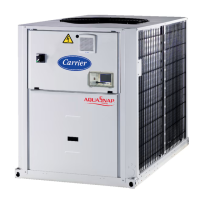
